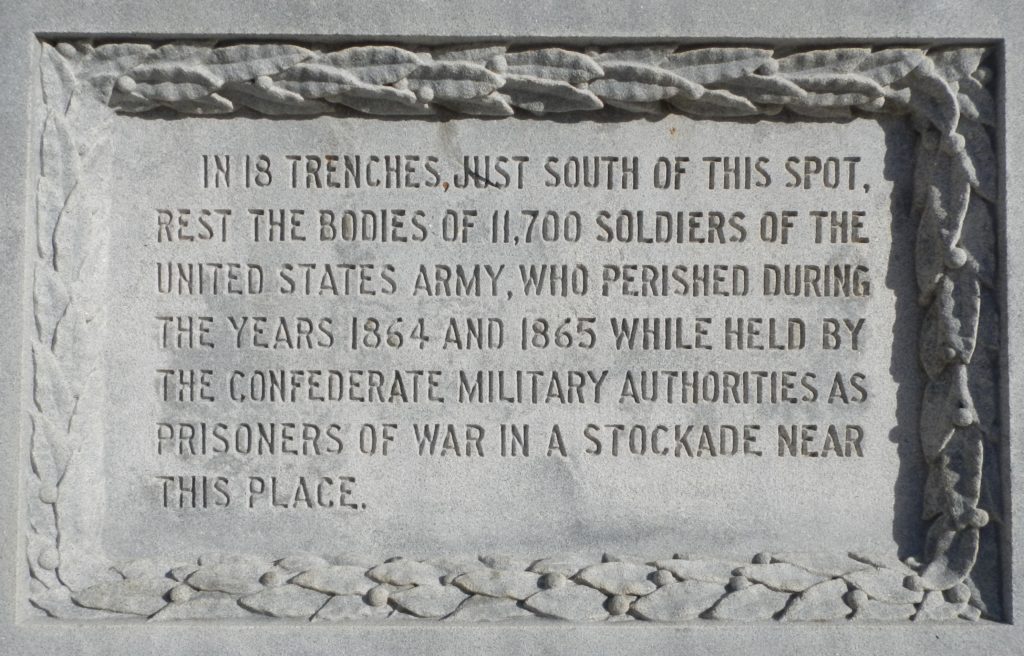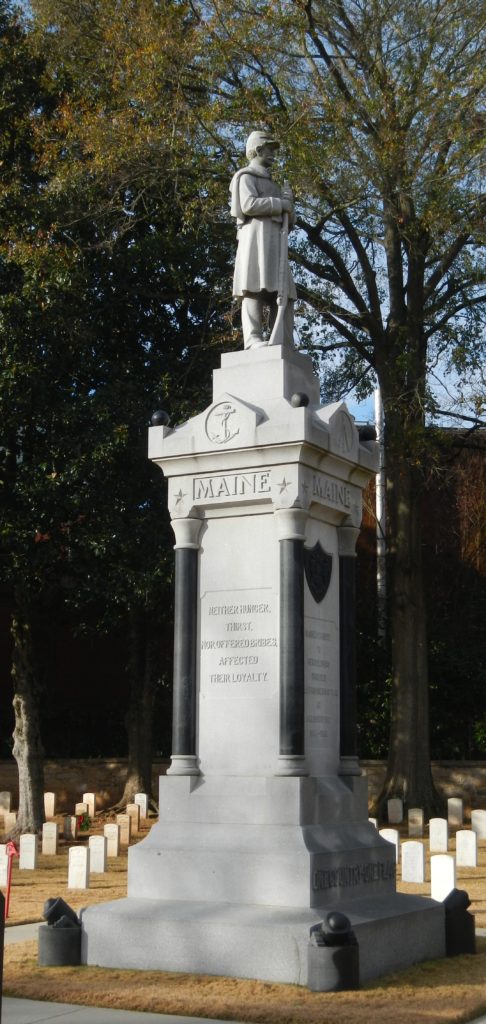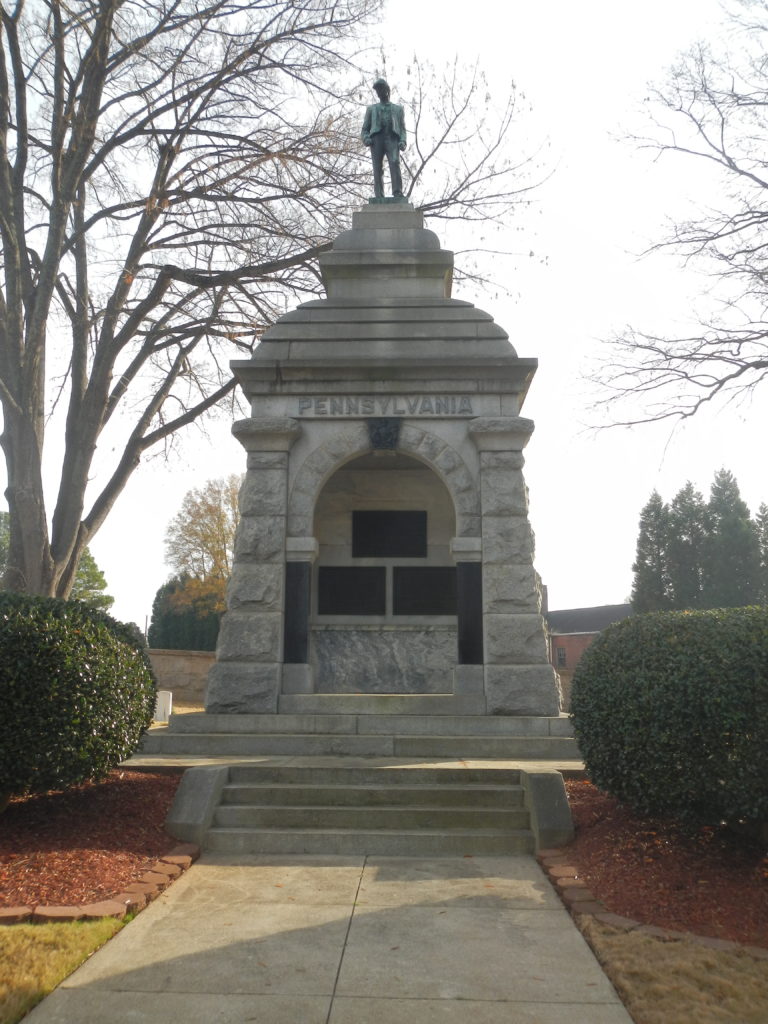I was moved when I visited the Salisbury National Cemetery. This national cemetery, tucked into downtown Salisbury, Rowan County, North Carolina, has a sense of peace that belies its beginnings. If you are in the area, you should visit the hallowed grounds of this cemetery and honor the sacrifices that these brave men made for our freedom. The cemetery has an historic section and an Annex that is located behind the William “Bill” Hefner Veteran Administration Medical Center (VA). The cemetery is very well kept and evokes memories of Arlington National Cemetery, although on a smaller scale. The grounds are open daily from dawn to dusk and you will find a quiet solitude when you walk the grounds.

Some Background on the Salisbury Prison and Cemetery
The stories about the Salisbury Prison vary, depending on the view point of the storyteller. Never the less, the site will always be hallowed grounds.
Conversion of the Mill to a Prison
In an article penned and printed in the NC Observer in 1893, Reverend A. W Mangum noted that the site was originally a large steam cotton factory established in Salisbury, North Carolina in February 1839 (Mangum). After a few years, the factory closed, and the property passed into the hands of Davidson University. After North Carolina seceded from the Union in 1861, the lot and buildings were conveyed to the Confederate States. The site was used as prison for Confederates under sentence of court martial, those arrested for disloyalty, deserters from the Federal army and for prisoners of war (POW). The multi-story mill had the advantage of being near a rail line
(Mangum).
Prison Life
The number of prisoners began small, only 120 in December of 1861 (Wikipedia). Initially, the prisoners were treated quite well. Prisoner exchange kept the prison populations down until around 1864, as the intensity of the war had depleted resources and was straining the infrastructure needed to deal with large numbers of POWs (VA). In the Fall months of 1864, the prison population at Salisbury exploded to over 10,000 as immense trains of prisoners began to arrive at the site. There was not enough tents to keep the prisoners from the elements and a scarcity of tools, lumber, and guards to construct shelter. Some prisoners had to sleep in the elements or resort to burrowing in the earth to get out of the weather (Mangum).
Large numbers of the prisoners were unable to walk and had to be carried from trains to the prison, many were filthy and ragged with meager clothing and no blankets for warmth during the winter months. It became difficult to feed the prison population as the war had taken a toll on food supplies. Water supplies for drinking, cooking and washing were also insufficient (Magnum).
Glazer transcribed the testimony of several members of the press that relayed that the prisoners at Salisbury suffered considerably for food and shelter. Frequently the prisoners received no rations for 24 or 48 hours (Glazier). The poor conditions in the prison directly resulted in many succumbing to disease or starvation (Wikipedia).
Death Came to Many
Between the beginning of October 1864 and the middle of February 1865, there were 3,419 prisoner deaths (Mangum). Mangum wrote:
“[t]here was a small brick building near the centre of the prison, which was used as a receptacle for the dead until they were carried to the burial ground. They were hauled thence, without coffins, to the old field west of the prison. A detail, first of convicts and afterwards of prisoners of war, was kept day by day, constantly digging the long pits in which they were interred. These pits were four feet deep, a little over six feet wide, and were extended parallel, about sixty yards. The bodies were laid in them without covering, there was not material to cover the living, much less the dead. They were laid side by side, as closely as they would lie, and when the number was too large for the space that was dug, one would be placed on top between ever two” (Mangum).

No burial records for the Prison were found, no way to identify the individuals that were dead as all buried there were listed as “unknown” (Penn). The hospital records did contain the names of 3,504 men who died in the hospital, and of that number 736 were from Pennsylvania (Pennsylvania). The plaque above is on the cemetery grounds to commemorate the unknown soldiers that had died at the prison and were placed in the mass graves. While there are differences of opinion about the number of people that were buried in the trenches, it makes this place no less sacred.
Transformation to a Prison to a Supply Depot
By early 1865, many of the prisoners were moved from the site. Over 3,700 who were able to march, were sent to Greensboro where they were taken by train to Wilmington, North Carolina. An additional 1,420 were transferred to Richmond, Virginia. When Union General George Stoneman made his way to Salisbury, the prison had been transformed into a supply depot. The prison was ordered burned and a fence was constructed around the graves that were on the site (Wikipedia).
Designation of the Prison Site as a National Cemetery
The Salisbury National Cemetery started as a place to inter the Union prisoners that died while in the Salisbury Prison. North Carolina ceded the land for the cemetery to the United States in 1872 (Judge Advocates). The site was designated a national cemetery in 1874. The following year a wall was built around the perimeter of the site (VA).
Monuments
Over the years, multiple monuments have been constructed at the cemetery. In December of 1876, a Federal Monument to the Unknown Dead, measuring 50-foot, was erected to honor the unknown soldiers who died in the prison. In June 1908, when the monument to Maine’s soldiers, a 25-foot granite monument to memorialize the soldiers the state lost, North Carolina dispatched their Secretary of State, J Bryan Grimes, to represent the State of North Carolina at the dedication. Secretary Grimes did not have time to prepare his remarks ahead of the dedication but spoke about North Carolina’s and the nations losses from the war. In his remarks, J Bryan Grimes, whose father was a major general in the Army of Northern Virginia, noted that

“We did not sustain your prisoners with the comforts or with the rations to which they were accustomed. We did not have them for our own men…and we could not feed our prisoners as they should be fed. Your prisoners in our hands lacked the medical attention which they should have had. The Federal Government declared medicines to be contraband of war and we could not obtain them…” (Grimes).
In December 1910, the State of Pennsylvania dedicated a 40-foot monument to honor the Pennsylvania volunteers that died as POWs in the Salisbury prison. Pennsylvania estimated that around 2,500 of their soldiers died in the Salisbury Prison between 1861-1865 (Pennsylvania). The State took a huge delegation by train to the dedication of this memorial. The delegation consisting of many prison survivors and dignitaries. Unlike the dedication of Maine’s memorial just two years earlier, then Governor W. W. Kitchen and the local community welcomed the Pennsylvania officials.

In addition to Civil War monuments in May 1990 an All Wars Monument was donated by the Rowan County Veterans Council that recognizes the service from all branches of the military (shown as the featured photo for this article). The 4th Marine Division also erected a memorial to honor their fallen in 2002.
National Registry of Historic Places
Salisbury National Cemetery was placed the National Registry of Historic places in 1999, at which time the Veterans Administration announced that it would donate an additional 40 acres to the site to ensure that there was space for burials to continue.
- Glazier, Willard W. The Capture, the Prison Pen, and the Escape, Giving a Complete History of Prison Life in the South, H E. Goodwin, Publisher, Hartford, CT, 1869, pgs. 323-329.
- Grimes, J Bryan. Remarks of J Bryan Grimes, Responding for the State of North Carolina, Upon the Occasion of the Dedication of the Maine Monument at Salisbury, NC, 08 May 1908.
- Mangum, A. W. Salisbury (N.C.) Confederate Prison, Publications of the Southern History Association, Washington, DC, October 1899, Vol III, No. 4, pgs 307-336.
- Pennsylvania, Salisbury Memorial Commission. Ceremonies at the Dedication of the Memorial, C. E. Aughinbaugh, Printer of the State of Pennsylvania, 1912.
- U. S. Judge Advocate General’s Office, Department of the Army. Military Reservations, National Military Parks, and National Cemeteries, Government Printing Office, 1898, pgs 181-182.
- Veterans Administration, National Cemetery Administration, Salisbury National Cemetery, accessed on 04 January 2019 at https://www.cem.va.gov/cems/nchp/salsisbury.asp
- Wikipedia, Salisbury National Cemetery, accessed on 04 January 2019, at https://en.wikipedia.org/wiki/Salisbury_National_Cemetery

Leave a Reply